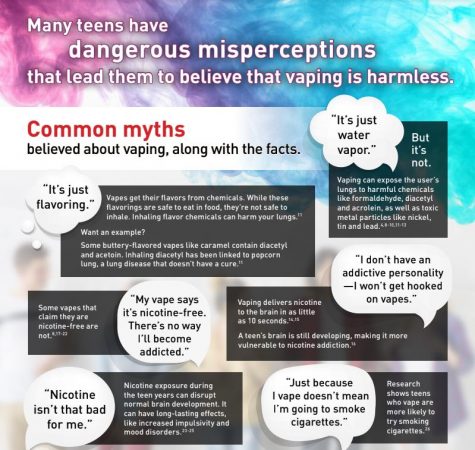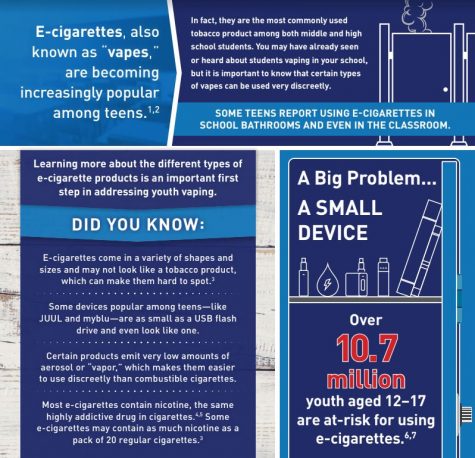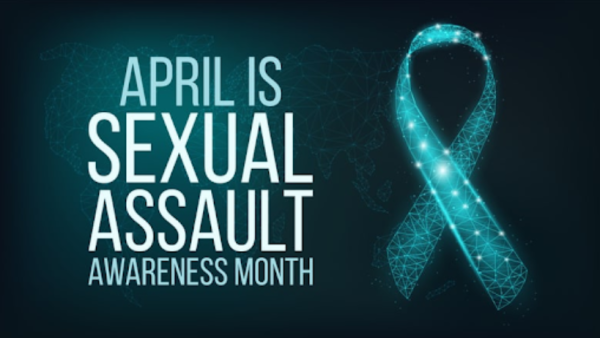The Unspoken Dangers of Teen Vaping
On March 11, 2019, students from six Fauquier schools attended a conference to inform students and faculty about the effects and the history of e-cigarettes and what the nation is dealing with on nicotine addiction on a large scale. Many students were able to listen to the conference speaker Linda Hancock and discuss how these devices affected their own schools personally.
Adolescence is the most significant time for brain development in young adults. Disrupting this development with nicotine at such a young age can introduce many risks, such as addiction and chemicals that can leave long lasting effects. Many teenagers that use e-cigarettes are clueless to the actual ingredients that are involved.

According to drugabuse.gov, in a survey asking teens if they know what’s in their e-cigarette, 66% thought it only contained juice flavoring and 13% did not even know what they were inhaling. It was not until August 10, 2018 that the FDA require all tobacco covered products to provide health warnings on their packages, according to fda.gov.
“Purchasing e-cigarettes are very appealing to adults and teenagers because of them being so uninformed on the ingredients that are in them. It can be something that a parent is willing to buy their child because of how much it is advertised as a good and safe product compared to normal cigarettes, when in reality they are more dangerous,” said school nurse Mrs.Waleska.
Sweet, fruity flavors such as mango and cucumber lure in many young people that can be unaware of the harms and dangers.
“When you make a product that you can personalize with all these various skins, have juice flavoring called blow sauce, and have different flavors like cotton candy and versions of e-cigarettes where you can play games on, there is no way they were not marketed for the youth,” said English teacher and leader of the Herren Project, Ms. Michelle Clark.
The initial purpose of electronic cigarettes were to help adults quit smoking. The first non-cigarette device was credited to Hon Lik in 2003. With the hopes to quit his own smoking habit himself, he had not managed to quit and currently uses both e-cigarettes and cigarettes, according to theguardian.com.

Many people are under the impression that vaping is a tried and true method to reduce or quit smoking, however, it is not FDA approved, and these products have not been around enough for long term studies to be conducted.
“A recent CDC study found that many adults are using e-cigarettes in an attempt to quit smoking. However, most adult e-cigarette users do not stop smoking and are instead continuing to use both products,” according to cdc.gov.
While there have been various progression among the depletion of teenagers usage of e-cigarettes, they are still rapidly making a variety of these without the harsh feeling when inhaling, which can be very dangerous for young people that are utilizing these devices. It makes it simple for them to acquire nicotine addictions without even realizing.
Since the brain does not fully develop until around the age of 25, younger people are at higher risk with their health regarding nicotine. This includes mood disorders and the decline of impulse control. Nicotine always causes a change in the way a person’s synapse is made. This can harm parts of the brain that power attention and learning says surgeongeneral.gov.
According to drugabuse.gov, after various use of nicotine, it disrupts people neurotransmitter acetylcholine and the receptors it connects to. Their receptors are using more energy and activity because they are being activated by nicotine and acetylcholine. The brain reacts by lessening the amount of acetylcholine and the brain relies on nicotine to do regular functions.
Aerosol in electronic cigarettes are not as harmless as many people believe to be. According to e-cigarettes.surgeongeneral.gov, Aerosol in e-cigarettes contains flavoring such as diacetyl, a chemical linked to serious lung disease; volatile organic compounds such as benzene, which is found in car exhaust; and heavy metals such as nickel, tin, and lead.
The FDA has made many new regulations to attempt to prevent the youth in tobacco use. The FDA has put a ban on all flavored e-cigarettes that do not have places that prohibit teenagers under 18.
“As far as people getting a hold of things, people are going to be able to obtain things regardless of what the law says, whether they are 13 to 19. I hope these new bills and laws being passed make it harder on the people marketing these products. At the presentation there had been many kids who had said there were many places available that would sell tobacco and nicotine and nobody would check them, or they would have friends that would buy it for them,” said Mrs Clark.
They have also “partnered with the Federal Trade Commission to target e-liquid manufacturers whose products used misleading, kid-appealing imagery that mimicked juice boxes, lollipops and other foods,” said FDA commissioner Scott Gottlieb.
States are also taking action by raising their legal age to buy tobacco products from 18 to 21, with Virginia soon becoming one of them.
“Philip Morris, the creator of Marlboro cigarettes, actually suggested changing the age from 18 to 21 to Congress in order to come off as the good guy, because he had just recently bought almost 80% of the vape and juul industry. I think that the law will seem like it’s better, but in reality, the age limit is 18 currently and kids under 18 have access to it just as well as 18 year olds. And a lot of kids in high school make some of their money by selling vape juices and JUUL pods to their friends so they will find anyway to get it,” said sophomore Sara Clark.






Tara • Mar 10, 2020 at 1:50 pm
great article!
Christian Torres • Mar 2, 2020 at 9:22 am
Good article nice to see someone cares about the well being of others.
Alia Arellano • Feb 27, 2020 at 12:56 pm
Wow I knew that vapes were bad but I had no idea they were this bad. I really hope that the people who use these products learn more about what they are doing and how they could be causing themselves some major health problems in the future. I ma very happy that my family has always told me to stay away form these types of things and that they always tell me that these things are very dangerous products.
Tiffany Davenport • Jan 30, 2020 at 6:47 am
Great article Giselle! I have to agree that changing the age isn’t going to do much. If people want something, they will always try to find a way to get it. I just hope that people reading the article will understand the dangers of vaping and make good, healthy choices!
Dallas Alphonso • Jan 24, 2020 at 10:33 am
dangerous